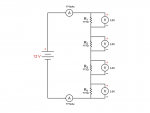I use a several pretty standard green laser pointers for work. I use them to paint tracking points on far away surfaces when filming for visual effects. However, they require AAA batteries which die at random times and basically don't work at all in colder weather. Also, replacing the batteries in a hurry is a pain in the butt.
What I'd like to do is build my own rig, where I have several lasers hooked up to a single power source. So here are my questions...
1) Where is the best place to buy a trustworthy green laser diode with the below specs...
- 532nm
- Class IIIA
- 5mW max output
- IR sheild/filter
- built in current regulator/controller (is this what it's called?)
- sharp, clean dot projection
2) What's the best battery to use? I was thinking something like a 12V RC LiPo, or perhaps just a 12V Lithium Ion of some sort, but I should be rechargable and robust?
3) What's the best configuration to hook up several lasers to the single battery? In series, in parallel? How many can I hook up to one battery? I expect I'll need to build a proper circuit with resisters, etc, but I'm a newbie to this so looking for some help here. Ideally I'd like to build a rig where I have about 6 lasers connected to a single battery, if possible. I was thinking something like the attached schematic?
4) If I'm over complicating this, I'm OPEN to suggestions. Perhaps something as simply as a AAA to DC power source conversion kit?
What I'd like to do is build my own rig, where I have several lasers hooked up to a single power source. So here are my questions...
1) Where is the best place to buy a trustworthy green laser diode with the below specs...
- 532nm
- Class IIIA
- 5mW max output
- IR sheild/filter
- built in current regulator/controller (is this what it's called?)
- sharp, clean dot projection
2) What's the best battery to use? I was thinking something like a 12V RC LiPo, or perhaps just a 12V Lithium Ion of some sort, but I should be rechargable and robust?
3) What's the best configuration to hook up several lasers to the single battery? In series, in parallel? How many can I hook up to one battery? I expect I'll need to build a proper circuit with resisters, etc, but I'm a newbie to this so looking for some help here. Ideally I'd like to build a rig where I have about 6 lasers connected to a single battery, if possible. I was thinking something like the attached schematic?
4) If I'm over complicating this, I'm OPEN to suggestions. Perhaps something as simply as a AAA to DC power source conversion kit?






